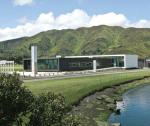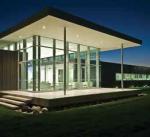Pelorus Trust Sportshouse Hutt City
Hutt Park is one of the treasures of Hutt City with its ports fields, nine-hole golf course and camping ground among its many facilities. But when harness racing’s Hutt Park Raceway folded in 2002, Hutt City Council was left with a bit of an eyesore at the southern end of the park with the old racetrack and its increasingly derelict buildings remaining.
So the council was delighted when they were approached by Pelorus Trust, who wanted to build a 'sportshouse’ to accommodate sporting organisations on part of the old raceway site. The proposal not only meshed perfectly with the council’s proposed redevelopment of the southern end of the 35ha park but would also bring social, recreational and economic benefits.
An agreement was reached under which the Trust pays a peppercorn rental to the council for the use of the land.
Alister Skene, who recently retired as Pelorus Trust manager, says developing the sportshouse was quite a departure from the normal business of the Trust, which distributes money raised from gaming machines to community groups.
“We believe this is a first for the charitable gaming sector which has traditionally been a passive recipient of applications for community funding,” he says.
“In this instance we have responded to a funding need which was identified by the likes of Sport Wellington Region and other sports organisations who were housed in inadequate accommodation.
“Our solution was to first promote the idea of the Sportshouse, and then bring it to fruition by providing a total design, project management, funding and ownership package.” The Trust commissioned architect’s Designgroup Stapleton Elliott lead by Nigel Dong, to come up with a cost-effective but ‘edgy’ concept for the sportshouse with a budget of about $6 million.
Alister says, “We are a community developer so, as we are using funds raised by the community through the operation of gaming machines, it was essential that every dollar spent was used to maximum effect.
Despite this we were determined to build a structure with a quality design aesthetic, one that reflected our desire to create a professional environment for sport to flourish in, and be proud of. The structure had to connect with the park and become an anchor for an emerging sports precinct.”
The planned 1440sq m facility would house up to 100 sports administrators, training and development officers, and support staff. The open plan nature of the complex is conducive to sharing ideas, resources and reducing costs. To attract tenants from their existing premises, rentals at the sportshouse are charged on a costrecovery basis.
What Designgroup Stapleton Elliott had to bring together under one roof was a building that demonstrates and reflects the principles of its tenants, who strive to promote fit and healthy lifestyles. The building also had to reflect the park-like setting and be environmentally friendly and energy efficient.
To deal with the Wellington weather, the structure also had to be robust externally, while coping with sustained use by many tenants meant it had to be durable internally. The spaces within had to be flexible to cope with different uses and changing tenants, and had to be designed to foster interaction between the different groups.
Nigel Dong says, “The Trust wanted something that was leading edge – the concept of a sports house was a first certainly for Wellington and probably nationally. We had to come up with a building design and amenity that would entice organisations to vacate their premises – so the building had to be like a beacon.”
Nigel says the decision to use metal roofing and cladding was due to cost-effectiveness and durability. The choice of angle seam cladding helps to accentuate the form of the building. To delineate the covered entrance from the dark body of the building, it has been rendered in white plaster and has a butynol rather than a metal roof. Metal flashing is used inside to frame some of the rooms.
“The metal was also taken into the building to celebrate the material,” says Nigel.
The low slung building has the foyer, café, meeting rooms and common areas at its centre with a large open plan office space either side and breakout rooms. On the northern side, one of the common areas extends out to the park and is glazed on three sides with wide eaves overhead covering and mirroring the
surrounding decking.
“The whole basis of that central area has been designed to open out on to the park,” says Nigel. “The whole space can be completely opened up and we deliberately kept the surrounding landscaping quite simple because of that.”
Recessed glazed end walls on the open plan office areas keep the spaces light and bright, emphasizing the philosophy of health and wellbeing.
The building seems to sit lightly on the site, with boulders scattered about its base. “We consciously raised the building to bring it above any potential flood plain – that was a council requirement but we took advantage of that to make it appear as it if was floating on the site,” says Nigel.
Founding tenants of the building are BikeNZ, Swimming NZ, Swimming Wellington, Softball NZ, GymSports NZ, Wellington Rugby League, Handball NZ, Bowls Wellington, Touch NZ, Sport Wellington Region and Leisure Active, a business unit of Hutt City Council that manages and co-ordinates the new facility as well as providing the organisations with expertise in event and programme management.
In the building’s forecourt sits Cube4, an artwork commissioned by Pelorus Trust. The interactive sculpture (resembling stacked but slightly askew boxes) by Waiheke Island sculptor Aiko Groot can be changed by turning handles on each side. Alister Skene says the project has met all the Trust’s objectives. “From our perspective, the building has been enormously successful – it is fully tenanted with 14 different sporting organisations utilising the facility along with countless community groups. It has been a fantastic project to be associated with.”
And it has met the council’s plans for the building to form part of a sporting precinct in that part of the park, with an indoor netball and cricket centre having gone up following the completion of the sportshouse.
Designgroup Stapleton Elliott
This architectural practice was created in 2009 from the merger of two successful and long-established firms, Designgroup Stapleton Architects and Designgroup Elliott Architects. The two firms had a strong history of collaboration on many award-winning projects and were both founding members of the Designgroup New Zealand affiliation.
Bringing together the complimentary and compatible skills of both firms and drawing on experience going back more than 40 years, Designgroup Stapleton Elliott provides clients with a broad range of architecture, interior design, urban design and project management services, with specialist experience in vocational tertiary education, community housing, urban renewal and healthcare. Central to the practice’s work is a belief that the quality of people’s surroundings has a direct influence on the quality of their lives.




